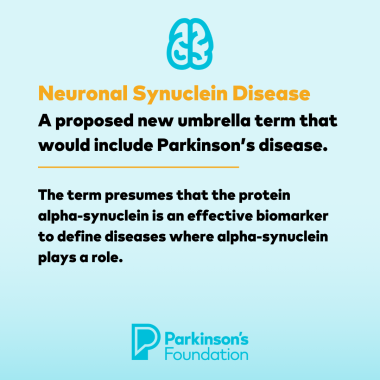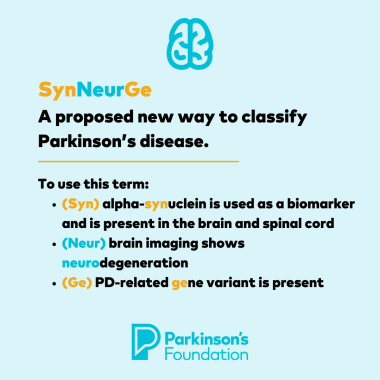Defining Parkinson’s Disease for the Next Generation of Therapies

As Parkinson’s research advances, experts are discussing how to biologically define and possibly classify Parkinson’s disease.
Right now, a discussion is gaining momentum among scientists researching Parkinson’s disease (PD) to use the latest advances in research to define Parkinson’s for the first time, based upon its biological signature. But why? And more importantly, what does this mean for those living with PD right now and the 90,000 people diagnosed every year?
Currently, diagnosing Parkinson’s is a mix of art and science. A PD diagnosis is made when a doctor weighs the evidence contained in a combination of symptoms (clinical hallmarks), response to dopamine therapy and use of in-office exams. Sometimes, brain imaging or a skin biopsy can be used to help support the diagnosis. Ultimately, there is no single test that can unequivocally confirm a person has Parkinson’s and no test to track disease progression.
Why Scientists Believe We Need to Define Parkinson’s
Parkinson’s research is advancing. We are getting closer to being able to use a biomarker to diagnose Parkinson’s. For example, high blood pressure is a biomarker for hypertension and blood glucose levels are biomarkers for diabetes. For PD, reliable biomarkers could one day potentially lead to an earlier PD diagnosis and help researchers design and test therapies that might slow or stop the disease.
For PD, the protein alpha-synuclein can act as a biomarker. Years of research show that this protein is involved in most but not all PD cases. While the alpha-synuclein protein has a useful role in the body, in PD, it becomes misfolded and damaged. This misfolding, much like a crumpled piece of paper, is associated with the damage of brain cells and the formation of alpha-synuclein clumps called Lewy bodies. These protein depositions pathologically define PD and the related disease, Lewy Body Disease or Dementia with Lewy Bodies.
We know from pivotal research, some of which was funded by the Parkinson’s Foundation and published in 2008, that misfolded alpha-synuclein can spread in the brain. The alpha-synuclein then acts as a “seed,” causing normal alpha-synuclein to form new clumps that change how brain cells work.
Recent advancements have opened the door for scientists to find misfolded alpha-synuclein in cerebrospinal fluid (CSF) of people with PD. This method for detecting abnormal alpha-synuclein is called alpha-synuclein seed amplification assay (SAA). In 2023, the accuracy of this approach was published. Recently in Nature, researchers from Japan published a blood-based approach to measure alpha synuclein.
Scientists believe the synuclein seed amplification assay could be an effective way to identify Parkinson’s in its “preclinical” stage, years before symptoms appear. However, the assay has its limitations. The testing method is not yet widely standardized and not all scientists have achieved the same results. The fluid required for the testing uses a spinal tap, which is a procedure that removes a small amount of cerebrospinal fluid and is not easily collected. The hope is that more serum and blood-based approaches will replace spinal fluid.
Also, the SAA assay test only confirms the presence of misfolded alpha-synuclein — it does not pick up all cases of Parkinson’s, especially cases of the LRRK2 genetic variant. Results cannot help scientists or doctors track disease progression, nor can it determine if someone who has misfolded alpha-synuclein — but no PD symptoms — will develop PD. Nevertheless, scientists — including those funded by the Parkinson’s Foundation — are working to overcome these limitations with the goal of re-engineering the SAA biomarker test to use a blood draw instead of CSF.
Scientists believe that using biomarkers to biologically define Parkinson’s can help identify early PD with more certainty and help to advance clinical trials. For now, alpha-synuclein is the first validated biomarker to be used in early clinical research. Researchers are already working on finding other PD biomarkers (through an MRI, skin biopsy and others) that can be used to diagnose PD and monitor its progression.
What’s in a name?
With the advancements being made in PD biomarkers, researchers are beginning to think about a new way of describing or “classifying” PD. This would provide a standardized way for researchers, doctors and epidemiologists (those who study disease) to describe PD and its various stages. This is in contrast with how we study PD right now, as Parkinson’s does not have a singular disease classification.
Because Parkinson’s is tied to the abnormal clumping of alpha-synuclein in the brain, some propose reframing “Parkinson’s disease” into a larger disease category. Two new approaches have recently been proposed:

1. Neuronal Synuclein Disease
The first presumes that alpha-synuclein is an effective, and potentially the only, biomarker to define diseases where alpha-synuclein plays a role, such as Parkinson’s and Lewy Body Disease (LBD). Researchers propose to use “Neuronal synuclein disease” as an umbrella term to describe PD and its alpha-synuclein related diseases as part of a proposed disease staging system (Simuni et al., 2024). This classification requires use of cerebrospinal fluid (CSF) and DaT brain scanning.

2. SynNeurGe
The second approach to classifying PD also relies on using alpha-synuclein as a biomarker but incorporates other disease features in classifying the disease (Höglinger et al., 2024). Here, researchers also use brain imaging and genetic status to define what is PD and what is not. The researchers do not propose changing the name of Parkinson’s disease but add the classification scheme, called “SynNeurGe” (pronounced synergy) alongside it.
Importantly, these two proposed approaches for defining PD lay important groundwork but also “underscores substantial knowledge gaps that deserve further study,” (Darweesh et al., 2024).
What This Means for The PD Community Right Now
The future of PD research lies in being able to define the disease based on a biological basis, which marks the beginning of more efficient ways to define, diagnose and treat PD. However, the work towards disease classification or a biological definition of PD will take time. Right now, these discussions do not impact how Parkinson’s is currently diagnosed or treated.
As researchers debate the merits of each approach (or even continue to propose new ones), it will take time to reach a consensus and to implement any changes to how PD is classified. If a new classification scheme is implemented, the likely first impact will be how clinical trials are conducted. Researchers may choose to fill research studies with participants who have received a diagnosis via the biomarker test, as they may respond better to certain drug treatments.
“Tying Parkinson’s disease to a new classification or definition is a new, evolving approach that will take time to first develop in research and then move into general use in the clinic. There will be ups and downs along the way, but with feedback from the community and continued advances in research the overall result will hopefully mean better care for people living with PD,” said James Beck, PhD, Parkinson’s Foundation Chief Scientific Officer.
In the meantime, it remains imperative that people who suspect they have Parkinson’s should be aware of the early signs and speak to their doctor. An early diagnosis will always remain the best course of treatment to maintain a high quality of life.
As research advances towards precision medicine, genetic testing is an important way researchers can help advance the field towards better treatments and diagnosis. Studies like PD GENEration: Mapping the Future of Parkinson's Disease are empowering people with Parkinson’s with their genetic status at no cost. These results can be shared with their doctor to guide treatment.
Here For the Parkinson’s Community
As this process unfolds, the Parkinson’s Foundation will continue to support innovative scientific research that improves life for people with PD and report any new information to our community. The Foundation continues to serve as a trusted ally to the Parkinson’s community, providing information that can help people navigate every stage of the disease.
Learn More
Learn more about advances in research by visiting the below Parkinson’s Foundation resources or by calling our free Helpline at 1-800-4PD-INFO (473-4636) for answers to your Parkinson’s questions.
Related Materials
Related Blog Posts


